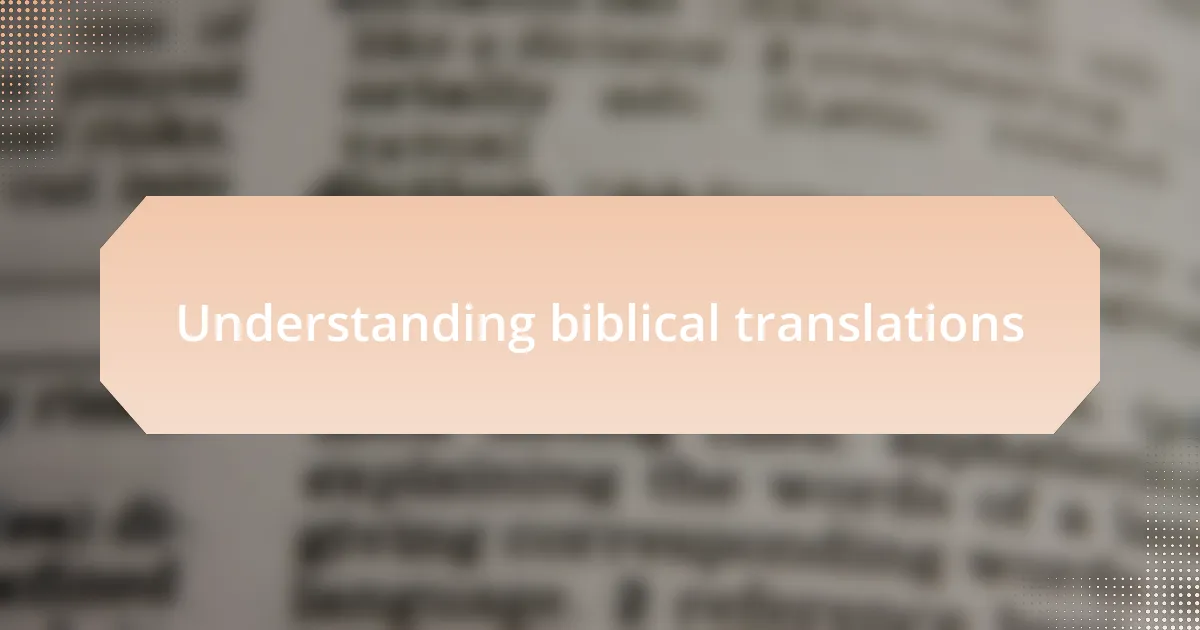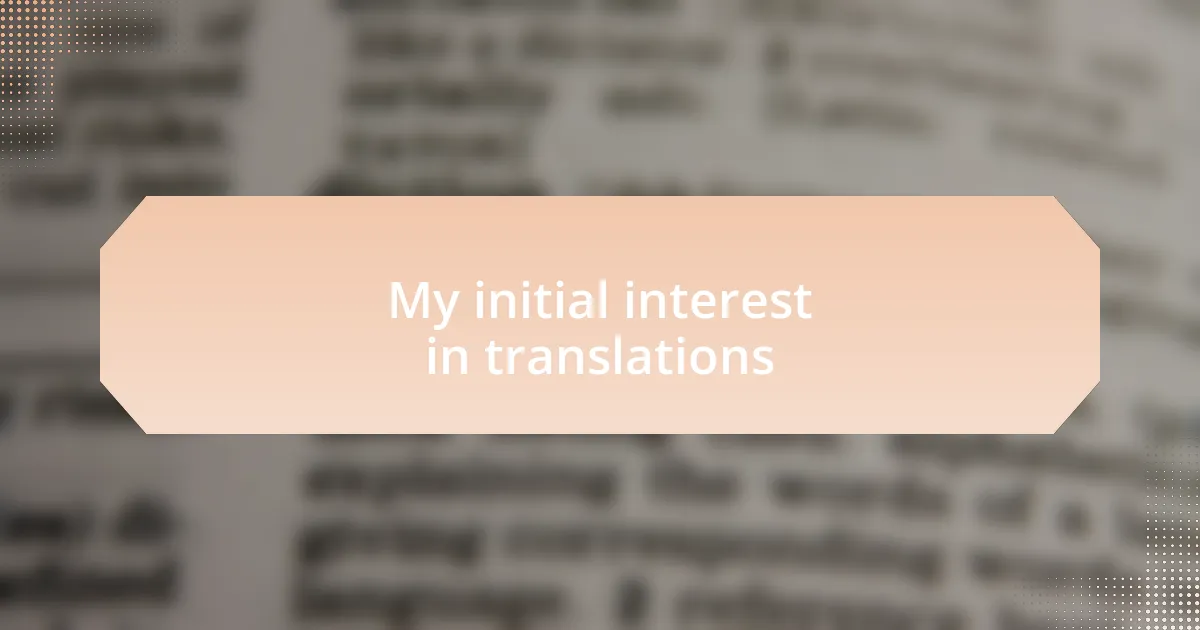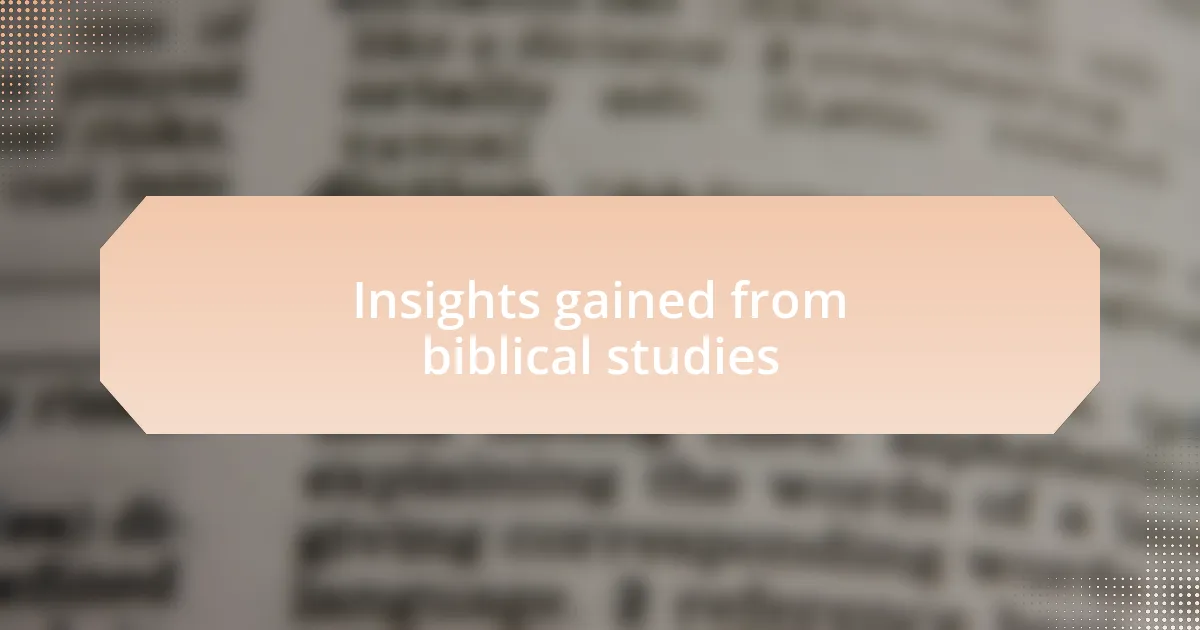Key takeaways:
- Exploration of biblical translations reveals the impact of language and theological perspectives on understanding scripture.
- Religious texts significantly shape identities, provide comfort, and encourage dialogue within communities.
- Nuances in translations can alter interpretations, highlighting the importance of context and the potential biases in individual readings.
- Personal encounters with different translations foster deeper connections with faith and challenge preconceived beliefs.

Understanding biblical translations
When I first ventured into the world of biblical translations, I was struck by the sheer number of versions available. From the King James Version to the New International Version, each translation reflects not just linguistic choices but also theological perspectives. It made me wonder, how do these differing interpretations influence our understanding of faith?
One moment that stands out in my journey was when I compared a passage in the New Revised Standard Version with its counterpart in The Message. The contemporary language of The Message resonated deeply with me, making ancient texts feel startlingly relevant. It was a reminder of how translations are not just about words; they encapsulate the cultural and spiritual context in which they were birthed.
As I explored more, I began to realize that translation is a complex balancing act. On one hand, you have the need for accuracy in conveying the original meaning, and on the other, the desire to make the text accessible to modern readers. This tension raises an important question: Do we sometimes lose the richness of the original scriptures in our pursuit of clarity? I often find myself grappling with this balance as I delve deeper into each translation.

Importance of religious texts
Religious texts hold profound significance, serving as the backbone of faith and community. I remember attending a community gathering where someone read a passage from the Torah. The way those ancient words connected us brought to life the essence of shared beliefs and traditions. In that moment, I understood that these texts are more than mere writings; they are living elements that shape our identities and guide our moral frameworks.
Moreover, the interpretations of religious texts can transform lives. Several years back, I encountered a struggling friend who found solace in a verse from the Quran that spoke of peace and perseverance. Seeing how those words offered her comfort made me appreciate how religious literature can be a source of hope and strength during challenging times. Have you ever experienced a moment where a single line from a scripture changed your perspective? I certainly have, and it deepens my respect for these texts.
Ultimately, the importance of religious texts extends beyond the written word; they are vessels of wisdom that transcend generations. As I explored various interpretations, I felt a responsibility to not only engage with them personally but to share their lessons with others. The stories, teachings, and reflections embedded in these texts encourage dialogue and understanding, connecting us with both the divine and each other in meaningful ways.

Overview of major translations
When considering major translations of religious texts, I can’t help but think about the impact they’ve had on believers throughout history. For instance, the King James Version of the Bible, published in 1611, is often regarded as a literary masterpiece that shaped the English language. I remember a moment in a literature class when we discussed the poetic rhythms of this translation, and it struck me how these ancient words still resonate with readers today.
Then there’s the Septuagint, the Greek translation of Hebrew Scriptures, which holds immense significance in the history of biblical interpretation. I once attended a lecture that highlighted its role in early Christian thought. Learning how this translation made the Old Testament accessible to a broader audience deepened my appreciation for how translations can expand understanding and foster connection among different cultures.
Another notable translation is the New International Version (NIV), which aims for clarity and accessibility in modern English. Reflecting on my own experiences, I recall using the NIV during a study group and finding that its straightforward language opened doors for rich discussions about faith. It made me wonder, how many beliefs have been shaped by the ability to engage with these texts in a language we understand? Through these translations, we see not just words, but bridges that connect us to divine wisdom across time and space.

My initial interest in translations
My initial interest in translations ignited during a family visit to a local bookstore. I stumbled upon a beautiful copy of the Revised Standard Version, its cover worn from years of handling. I remember opening the book, the smell of aged paper swirling around me, and feeling an undeniable pull toward the idea that each translation could reveal new layers of meaning, shaping an entirely different perspective on familiar stories.
In a college seminar focused on religious literature, I recall diving into discussions about the nuances lost or gained in translation. I found myself captivated by the idea that certain phrases could carry different weight depending on the language. One day, a classmate posed a question that resonated deeply with me: how can we truly understand the original intent of the authors if we only interact with translations? That moment sparked a craving in me to explore these differences further, to uncover the richness behind the words.
As I began to explore various translations on my own, I discovered the distinct emotions they evoked. I often picked up the Good News Translation late at night, drawn to its simplicity and warmth. Each page filled me with a sense of comfort, as if I were having a quiet conversation with an old friend. Was it possible that the emotional connection I felt stemmed directly from the translation choices made by the translators? This inquiry became a driving force in my journey, revealing the vital role translations play in personal and communal faith experiences.

Challenges faced during my journey
As I delved deeper into the world of biblical translations, I encountered the frustrating challenge of choosing the right edition to study. Each version seemed to present a different interpretation of key passages, and I often found myself torn. How could I reconcile my understanding of a beloved verse when translations differed so dramatically? This internal conflict often left me feeling overwhelmed, questioning which version accurately captured the essence of the original text.
I vividly remember a specific instance during a group study session at my church. We were analyzing the same verse from both the New International Version and the English Standard Version. The discussions revealed not only the differences in language but also the stark contrasts in the theological implications of those translations. I felt a sense of urgency to grasp these nuances, realizing that my own interpretations were influenced by the specific translation I favored. It left me pondering: had I unknowingly shaped my beliefs based on limited perspectives?
Another significant challenge emerged when I decided to tackle some of the more scholarly translations. I dove into the complexities of the Septuagint and the Vulgate, which often felt like wading through deep waters without a life jacket. There were moments I wanted to give up, feeling far removed from the straightforward stories I’d cherished in simpler translations. Yet, when I surfaced from those depths, I discovered a richer comprehension of the text. It became clear to me that these challenges, while daunting, were integral to my journey—each obstacle brought me closer to a profound understanding of my faith.

Insights gained from biblical studies
As I continued my exploration of biblical translations, I began to notice how the nuances in wording could shape entire interpretations of faith. For example, when I studied the Beatitudes in different versions, the slight variations in how blessings were articulated opened my eyes to broader spiritual truths. Have you ever considered how a single word can deepen your understanding of grace or mercy? It was through these reflections that I learned to appreciate the richness of biblical language.
One revelation that struck me was the importance of context in understanding scripture. I remember digging into the story of the Prodigal Son and realizing that cultural and historical contexts offered layers of meaning I had previously overlooked. In those moments, I found myself feeling a profound connection to the characters, as their struggles mirrored some of my own. Isn’t it fascinating how ancient stories can resonate so deeply with our modern lives?
Additionally, I discovered that different translations often reflect varied theological perspectives, an aspect I had never considered before. Engaging with translations like the New Revised Standard Version versus the King James Version, I noticed how each brought unique emphases to the text. This realization prompted me to question my own biases and assumptions about scripture. What if my interpretation had been limited by a single translation? This insight has been invaluable, prompting me to appreciate the diversity and depth within biblical studies and urging me to remain open-minded in my quest for understanding.

Personal reflections on translations
Immersing myself in different biblical translations has often felt like embarking on a treasure hunt. I vividly recall sitting in a quiet café, the smell of coffee filling the air, as I flipped through various versions of the Psalms. Each translation spoke to me differently, igniting deep emotions and reflections I hadn’t anticipated. How can a few words, rearranged or altered, evoke such a varied response within me? It made me appreciate that our personal encounters with scripture can shift significantly based on the language we engage with.
One time, while preparing for a small group discussion, I found myself grappling with the concept of love as presented in 1 Corinthians 13. I studied several translations, each illuminating aspects I had overlooked in the other. That journey was enlightening; I felt as though I were peeling back layers of my own understanding. Isn’t it interesting how a text can reflect our own journey and growth? This experience reinforced my belief that translation isn’t merely about converting words; it’s about connecting with the divine in a deeply personal way.
I’ve often wondered about the role of familiarity versus novelty in our spiritual lives. When I read passages I’ve known for years, they can feel like an old friend, comforting yet predictable. But encountering a fresh translation can be akin to meeting that friend in a new context—it challenges me and opens my mind. How often do we limit ourselves to a single perspective? This realization encourages me to continually explore new translations, always eager for the insights that lie just beyond my current understanding.